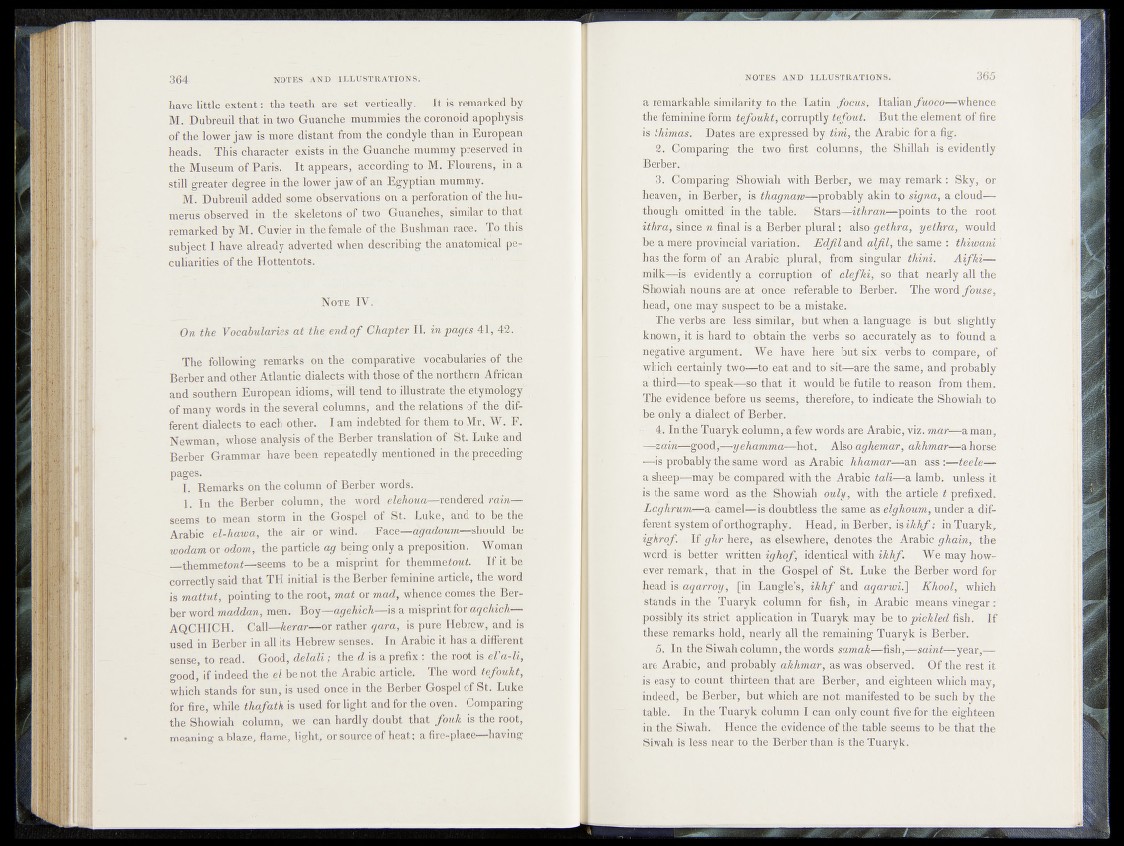
m m m wSSBssm
I f
l i
11 1m1l .
364. NQTBS AND ILLtFSTRATI#®»
have little extent: the teeth are set vertically. It is remarked hf1
]\4. Dubreuil that in two Guanche mummies the coronoid apophysis
of the lower jaw is mote distant from the condyle ,than in European
heads- This character exists'in the Guanche mummy preserved in
the Museum of Parisr.£ It appears, according to M. Flp_ur^||| in a
still greater-deg^e in the lower yaw of an Egyptian mummy.
M. Dubreuil added some observations on a perforation of the humerus
observed in the skeletons of two Guanches, similar to that
remarked by M. Cuvier in the female of the Bushman race. To this
subject I have already adverted when describing the anatOpaipal peculiarities
of the Hottentots.
N ote IV.
On the Vocabularies at the end o f Chapter IL in pages 41, 42:
The following remarks on thn comparative vocphglaries of. the
Berber and other Atlantic dialects with those Of tiielnarthefn -African
and southern European idioms," will tend to illus,t^fer'the e%miolQgy
of many words in the several columns, and the relations )|Mhe;,4iiif-‘
ferent dialects to eaeh other. I am indebted for- them5to.Mr. W.„ M
Newman, whose analyst of the Berber translation of; St. Luke and
Berber Grammar have been repeatedly mentioned in the^eeedmg
pages.
L Remarks on the column of Berber words.
1. In the Berber column, the word elekoup^xeadexed raintjik.
seems to mean storm in the Gospel of St. Luke, and to be the
Arabic el-hawa, the air or wind. - Face—mjtadottm—-should be
madam oxodom, the particle ag being only a preposition. Womap
^themmetorot—seems to be a misprint for themmetowt ^ ^ be
correctly said that TH initial is the Berber femininearticle, the word
is' mattut, pointing to the root, mat ox mad, whence comes the Berber
word maddan, men. Boy—agehich—is a misprint for aqchich—
AQCHICH. Call—kerar—ox rather qara, is pure Hebrew, and is
used in Berber in aU its Hebrew senses. In Arabic it has a different
sense to read. Good, deTali; the d is a prefix: the root is eVa-li,
good, if indeed the,«/ be not the Arabic article. The word tefoukt,
which stands for sun, is used once in the Berber Gospel of St. Luke
for fire, while tkafath is used for light and for the oven. Comparing
the Showiah column, we can hardly doubt that fouk is the root,
penning ablaze, flame, light,’or source of heat; afire-place—having
a remarkable similarity.,to the Latin|y&>eros-,' Italian fuoco—whence
the'.femininesfdrhi tèfon%fat corruptly tefout. But the element of fire
is t h im i f i S t p , I are^expiessfed'by tint,.the Arabic fora fig.
^Comparing thé w ;firfet Columns, the Shillali is evidently
^^■■^Comparirig Showiah with..Berber, we may remark; Sky, or
hpaven'7 in> Berber, is thagnarv—probably akin to signa, a cloud—
though, omitted’ in the table: pl^aT.s^i^ö^'ïr'Points to, the root
ithra, since; to final is a Berber plural; ;also,gethra, yethra, would
be a mere provincial1 variati owj'fKfLfi-1 and alfil, the same : thitoani
has the form of an Arabic • plural,' 'from singular thini. A ifk i—
milk—is evidently a corruption of alefki1 so- that neatly all the
Showiah nouns^are at once; „-referable to .'Berber. The word fotise>
head, one maysuspeetito.be amistake:
The verbs are less similar*'but when at language is but slightly
known, it is hard to obtain the verbs sl|jaccurately as to found a
neg^tive^argument. We .have.-here but six - verbs to compare, of
which-certainly two':—to-eat and -to sit—are the same, and .probably
a; third—-to -speak—-so that it would be futile to reason from them.
The evidence before us seems, therefore*-to indicate thé Showiah to
be only a dialect of Berber.
7 4. Inthe Tuaryk column,1 afiew words are Arabic, viz. »roar—a man,
—zaih—good,—?-yekomma—hot. Also aghemar, akhmar—ct, horse
•—is probably the same word as Arabic hhamar—an asS :-—teele—
a sheep^may be compared with the Arabic tali—a lamb, unless it
is the same word as the. Showiah only, with the.article t prefixed.
Laghrum—a camel-^is doubtless the same as elghoum, under.a different
system of orthography. Head, in Berber, is ik h f; in Tuaryk,
ighrof. If yhr here, as elsewhere, denotes, the Arabic the
word is better written ig h o f identical with ikhf. We may however
remark, that in the -Gospel of St. Luke the Berber word for
head is aqarroy, [in Langlee, ik h f and aqamvi.] Khool, which
stands in the Tuaryk column for fish*,.in Arabic means vinegar
possibly its strict application in Tuaryk may be to pickled fish. If
these remarks hold, nearly all the remaining Tuaryk is Berber.
5. In the Siwah column, the words samak—fish,—saint—year,—
are Arabic, and probably aMwmr, as was observed. Of the rest it
is easy to count thirteen that are Berber, and eighteen which may,
indeed, be Berber, but which are not. manifested to be such by the
table. In the Tuaryk column I can only count five for the eighteen
in the Siwah. Hence the evidence of the table.seems to be that the
Siwah is less near to the Berber than is the Tuaryk.